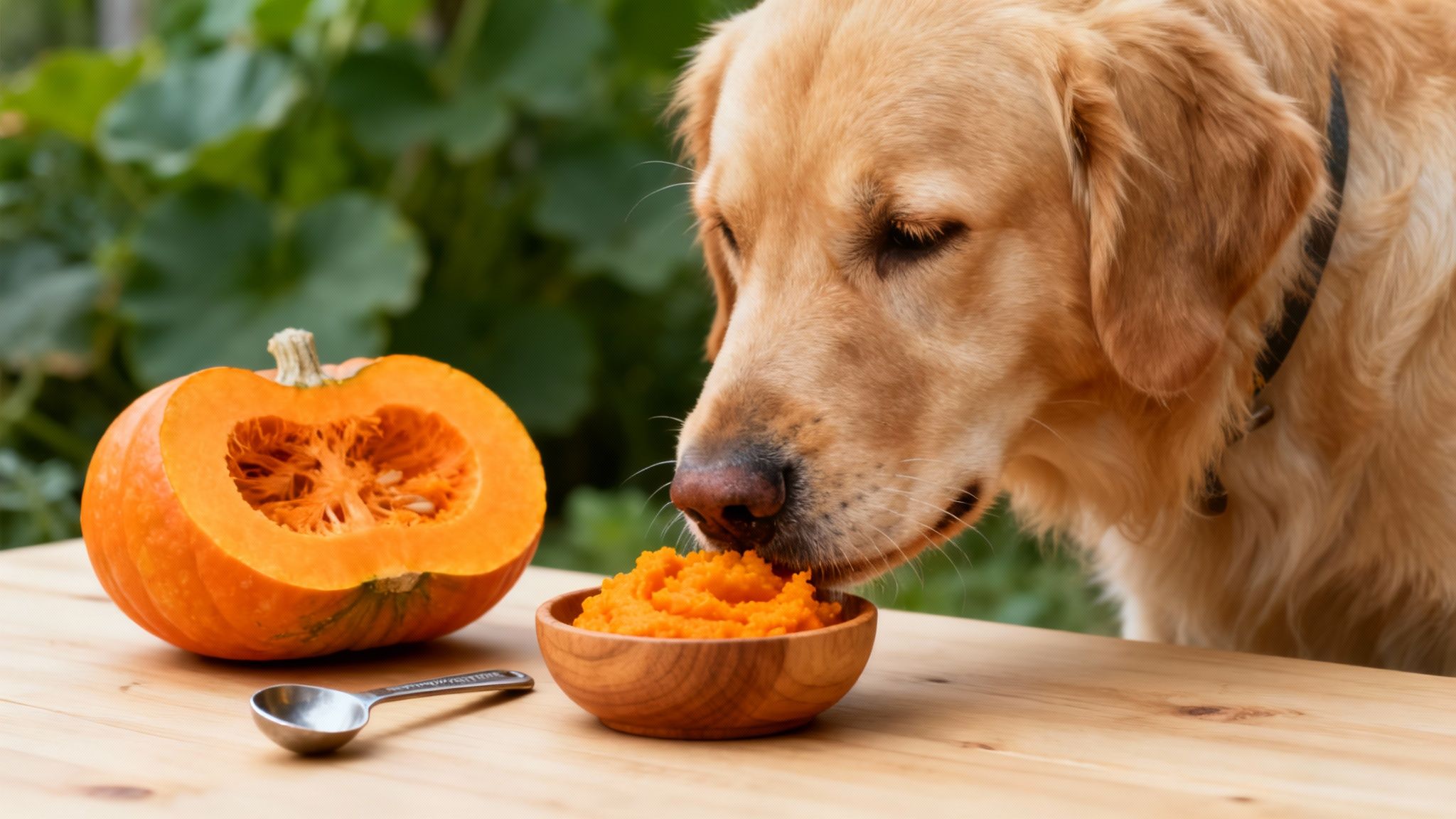Pumpkin for Dogs Digestion a Simple Guide
Is pumpkin for dogs digestion effective? Yes. Learn the correct dosage, safe preparation, and tips to soothe your dog's stomach with this simple guide.

Yes, pumpkin can be a fantastic, safe, and surprisingly effective tool for your dog's mild digestive troubles. Its unique fiber profile works wonders for both diarrhea and constipation, which is why so many vets (myself included) recommend keeping a can on hand. Just be sure you're grabbing 100% pure canned pumpkin puree—never the sugary pie filling.
Your Quick Guide to Using Pumpkin for Dog Digestion

When your dog's stomach is acting up, you want something that works fast without causing more problems. That's where pumpkin comes in. It has become a go-to home remedy for a good reason—it’s a simple, natural way to help get your dog’s system back on track, whether things are too loose or too backed up.
The real magic is in its blend of fibers. Pumpkin contains both soluble and insoluble fiber, and they work together to restore balance in the gut.
Think of it this way: the soluble fiber acts like a sponge, absorbing excess water in the colon to help firm up loose stool. On the flip side, the insoluble fiber adds bulk to the stool, which helps stimulate the intestines and get things moving when your dog is constipated. It’s this dual-action power that makes it so uniquely helpful. We dive deeper into the science behind canine gut health and pumpkin's role at Wagbar if you're curious.
Consider this your quick-start guide. We'll give you the essentials right away so you can feel confident helping your pup feel better, fast.
Pumpkin for Dog Digestion At a Glance
For a super-quick summary, here’s a simple chart breaking down what makes pumpkin so useful.
Keep this table in mind as we get into the nitty-gritty of how pumpkin works and the right amounts to give. It’s a handy reference for a simple, yet powerful, remedy.
It’s one of those things that sounds too good to be true, right? How can one food fix two totally opposite digestive issues? But the way pumpkin works its magic on a dog's gut is actually pretty simple. It all comes down to its unique blend of fibers.
Think of your dog's digestive system like a highway. Sometimes traffic is flying by way too fast (diarrhea), and other times, you’re stuck in a complete standstill (constipation). Pumpkin is like the perfect traffic cop, stepping in to get things moving just right.
Soluble Fiber: The Answer to Diarrhea
First up is soluble fiber. Just like the name implies, this type of fiber dissolves in water and creates a thick, gel-like consistency in your dog's gut.
When things are moving too quickly, this gel acts like a sponge, soaking up all that excess water. This slows the whole system down, adding much-needed bulk to loose, watery stools and helping them firm up. It’s a gentle way to bring calm to a chaotic, overactive digestive tract.
Insoluble Fiber: Getting Things Moving Again
Then you have insoluble fiber. This one is different; it doesn't dissolve in water at all. Instead, it travels through the digestive tract mostly intact, acting like a gentle scrub brush for the intestines.
For a constipated dog, this "brush" adds weight and bulk to the stool, which is exactly what’s needed. The extra size naturally encourages the intestinal muscles to get to work pushing everything along, clearing the jam. And because it doesn’t absorb much water, it helps keep the stool soft enough to pass comfortably.
The Dual-Action Takeaway: Pumpkin’s combination of a water-absorbing gel (soluble fiber) and a bulking agent (insoluble fiber) is what makes it a vet-recommended remedy for both diarrhea and constipation. It intelligently adapts to what your dog's gut needs.
This powerful duo is why so many dog owners (and vets!) swear by having a can of pumpkin in the pantry. It’s not just an old wives' tale; it’s a simple, biological process that helps guide your dog’s system back to a happy, healthy normal. Once you understand the science, you can feel confident using it to give your dog safe and effective relief.
Choosing and Preparing the Right Pumpkin for Your Dog
When you’re reaching for pumpkin to help your dog’s tummy, the kind you pick makes all the difference. Get this part wrong, and you could accidentally make things worse. The golden rule is simple: plain is always best.
Your go-to option should be 100% pure canned pumpkin puree. There's a reason vets and experienced owners swear by it. It’s incredibly convenient, has a more concentrated punch of fiber and nutrients than fresh pumpkin (since it has less water), and is ready to go right out of the can. Just be sure to read the label—the only ingredient should be "pumpkin."
The Dangers of Pumpkin Pie Filling
This is a big one: never, ever give your dog pumpkin pie filling. It might sit right next to the pure puree on the grocery store shelf, but it's a world apart. This stuff is packed with sugar and spices that can be toxic to dogs.
One of the worst offenders in pie filling is nutmeg. It contains a toxin called myristicin that, even in small amounts, can cause serious problems for dogs, including disorientation, a racing heart, and even seizures. Other spices like cloves and allspice can also wreak havoc on their stomach.
Always take that extra second to double-check the can. You're looking for pure puree, not a pre-sweetened, spiced-up dessert mix.
To make it crystal clear, here’s a quick guide to what’s safe and what to leave on the shelf.
Safe vs Unsafe Pumpkin for Your Dog
Choosing the right type is non-negotiable for your dog's safety and well-being.
Preparing Fresh Pumpkin Safely
If you'd rather make it yourself, fresh pumpkin is a fantastic option, as long as you prep it correctly. Raw pumpkin is just too tough for a dog's digestive system to handle and poses a choking risk.
Just follow these simple steps:
- Start with a small pie pumpkin, not one of the big ones meant for carving.
- Scoop out the seeds and stringy guts, then remove the stem and tough outer skin.
- Roast or steam the pumpkin flesh until it’s fork-tender.
- Toss the cooked pumpkin into a blender and puree until it’s perfectly smooth. Don’t add a thing—no salt, no sugar, no spices.
You can keep your homemade puree in the fridge for a few days or freeze it in an ice cube tray for easy, pre-measured servings later on. It's this properly prepared pumpkin that delivers the one-two punch of soluble and insoluble fiber.

This simple visual perfectly illustrates pumpkin’s dual benefits: the soluble fiber acts like a sponge, absorbing water, while the insoluble fiber works like a broom, sweeping the digestive tract clean.
The pet food industry has certainly caught on. One analysis found that by 2017, pumpkin was already included in nearly 20% of all dry dog food recipes. It's clear that this humble squash has earned its reputation as a powerhouse for canine gut health. You can read more about pumpkin's rise in commercial pet food formulations at Petfood Industry.
Finding the Correct Pumpkin Dosage for Your Dog

When it comes to using pumpkin to help your dog's digestion, getting the amount right is everything. It’s incredibly safe and helpful, but too much of a good thing can backfire and cause the very issues you're trying to fix. The trick is to treat it as a fiber supplement, not a full-on meal.
A great rule of thumb to start with is one teaspoon of pumpkin puree for every 10 pounds of body weight, given per meal. This isn't set in stone, but it’s a reliable and safe starting point for most dogs.
I always recommend starting with a little less than you think you need, especially for dogs with sensitive stomachs. This "start low and go slow" approach gives you a chance to see how their system handles the extra fiber without overwhelming it.
Dosing Guidelines by Dog Size
To make things even simpler, here are a few general recommendations based on weight. Just remember to split the total daily amount between their meals.
- Small Dogs (Under 20 lbs): Aim for 1 to 2 teaspoons per day. A tiny Yorkie will likely only need that single teaspoon, while a sturdier Pug might do better with two.
- Medium Dogs (20-50 lbs): A daily dose of 1 to 2 tablespoons usually hits the mark for breeds ranging from Beagles to Australian Shepherds.
- Large Dogs (Over 50 lbs): You can safely give 2 to 4 tablespoons per day. A Labrador Retriever might be perfect with three tablespoons, while a much larger Bernese Mountain Dog could need four.
Crucial Tip: Fiber can't work its magic without water. Any time you add pumpkin to your dog’s bowl, make absolutely sure they have plenty of fresh, clean water available. Good hydration is what helps that fiber move everything along smoothly.
Fine-Tuning the Amount
Think of these guidelines as a launchpad, not a strict prescription. Every dog is different.
The real test is observing your dog's stool quality after you've added the pumpkin. If their poop becomes too soft or loose, you're likely giving a bit too much. On the flip side, if you're trying to relieve constipation and don't see an improvement in a day or two, you can slowly increase the amount.
Finding that sweet spot is all about observation and making small, gradual adjustments. It’s a simple way to use this amazing superfood to keep your dog’s digestive system happy and healthy.
Supporting Long-Term Gut Health with Pumpkin
Pumpkin is a fantastic tool for sorting out immediate tummy troubles, but it's much more than just a quick fix. Think of it less as a band-aid for an upset stomach and more as a long-term investment in your dog’s gut health. This is where pumpkin’s role as a powerful prebiotic really shines.
Let's imagine your dog's gut is like a garden. The good bacteria, or probiotics, are the vibrant flowers you want to see flourish. Prebiotics, then, are the special fertilizer that helps those flowers grow strong and crowd out all the nasty weeds.
Fueling the Good Bacteria
Pumpkin’s soluble fiber is the star ingredient in this "fertilizer." It doesn't just pass through your dog's system; it gets to work. As it moves into the colon, this fiber ferments and literally becomes food for the beneficial gut bacteria.
This process creates a healthy, soupy mix that feeds the good bugs, helping them multiply and build a stronger, more resilient gut environment. It’s a simple but powerful way to keep their internal ecosystem in balance. You can learn more about pumpkin's role in the gut microbiome on Veterinary Formula's blog.
A well-fed microbiome does more than just digest food. It strengthens the gut lining, helps your dog absorb more nutrients from their food, and even regulates their immune system—a huge part of which is located right in the gut.
By consistently feeding the good bacteria with a prebiotic source like pumpkin, you're not just reacting to symptoms. You're proactively building a foundation for lasting digestive wellness.
A Strong Gut Supports Overall Wellness
A healthy gut has a ripple effect on your dog’s entire body, impacting much more than just their poop. When the good bacteria are thriving (thanks to fuel from things like pumpkin), you'll start to see benefits in some surprising areas.
For instance, have you ever dealt with anal gland issues? It’s not fun for anyone. Firm, well-formed stools are essential for helping those glands express naturally every time your dog goes to the bathroom. The fiber in pumpkin helps create the perfect consistency to get the job done, which can mean fewer uncomfortable blockages and fewer trips to the vet for manual expression.
Adding a little bit of pumpkin to your dog’s daily meals is an easy, proactive step for their overall health. It works hand-in-hand with daily supplements like FORMA chews, which offer a broad range of nutrients for immunity, gut health, and longevity. When you combine these two, you create a powerful daily routine that supports your dog from the inside out, keeping their internal garden thriving for years to come.
Knowing When to Call the Vet
While pumpkin can be a fantastic tool to have in your dog-care arsenal for mild tummy troubles, it’s really important to know its limits. Think of it as a helpful home remedy, not a magic cure. Some situations absolutely need a vet’s attention, and being able to spot the difference is key to keeping your dog safe.
As a general rule, if your dog’s constipation or diarrhea doesn't clear up after 48 hours, it’s time to call the vet. A problem that hangs around that long usually points to something more serious that a spoonful of pumpkin just can't fix.
Beyond that time frame, there are a handful of symptoms that should send you straight to the phone. These are the big red flags that tell you to get professional help right away.
Red Flags That Require a Vet Visit
If you see any of the following signs along with the digestive upset, please don't wait. Contact your veterinarian immediately, as these can point to a much more serious health issue.
- Extreme Lethargy: Is your dog suddenly weak, unusually tired, or just not responding like they normally do?
- Vomiting: This is a big one, especially if it's happening over and over, you see any blood, or it’s paired with diarrhea.
- Signs of Pain: Look for whining, a hard or tense belly, or yelping when you try to pick them up or touch their stomach.
- Blood in the Stool: This could be bright red streaks or stool that looks dark, black, and tarry.
- Loss of Appetite: It's a real concern if your dog turns their nose up at food for more than a meal or two.
- Dehydration: Telltale signs include tacky, dry gums, sunken-looking eyes, and a loss of skin elasticity (if you gently pinch the skin on their back, it doesn't spring back quickly).
Your Vet is Your Partner: When in doubt, always make the call. It's far better to get an expert opinion and find out it's nothing serious than to wait and wish you had acted sooner.
Using pumpkin is a smart way to handle minor digestive hiccups, but a huge part of being a great dog owner is knowing when to bring in the pros. Your vet has the training and tools to get to the bottom of the problem and make sure your best friend gets the right care.
Your Top Pumpkin Questions, Answered
Even after learning all the good stuff pumpkin can do, you probably still have a few questions floating around. Let's tackle some of the most common ones so you can feel totally comfortable adding this superfood to your dog's bowl.
Can I Give My Dog Pumpkin Every Day?
You bet. A small, daily dose of pumpkin is generally safe and can be a great way to support your dog’s gut health long-term. Think of it less like a quick fix and more like a consistent little helper for their digestive system, thanks to all that prebiotic fiber.
That said, moderation is key. Too much of a good thing can backfire, and with pumpkin, that usually means loose stools from the fiber overload. Just be sure to stick to the recommended serving size for your dog's weight and give your vet a heads-up if you plan on making it a permanent part of their diet.
How Quickly Will I See Results?
It really depends on what you're trying to help. If you're dealing with a mild case of diarrhea, the soluble fiber gets to work pretty fast absorbing excess water. You could see firmer stools in just a few hours.
For constipation, it's a bit of a slower process. The insoluble fiber needs time to work its magic, adding bulk to the stool and encouraging the intestines to get moving. You’re typically looking at somewhere between 12 to 24 hours for relief. If 48 hours go by with no improvement, it's time to call the vet.
How Do I Know if I'm Giving Too Much Pumpkin?
Funnily enough, giving too much pumpkin can cause the exact problem you're trying to solve. The number one sign is loose stool or diarrhea. If you notice your dog's poop getting softer after you've introduced pumpkin, you’re probably overdoing it.
Less common signs could be vomiting or a lack of interest in food. The fix is simple: just cut back on the amount or skip a day or two to let their system reset. When you reintroduce it, start with a much smaller dose.
Is Pumpkin Okay for Puppies?
Absolutely! Pumpkin is perfectly safe for puppies and can be a real game-changer for their sensitive little tummies. Pups are notorious for getting minor digestive upsets, and a bit of pumpkin can offer gentle, soothing support.
When giving pumpkin to a puppy, start small. And I mean really small—like half a teaspoon or even less for tiny breeds. Their digestive systems are still developing, so a little bit goes a very long way. Always begin with a tiny amount and keep a close eye on how they respond.
Join thousands of pet parents getting science-backed health insights and natural care advice


